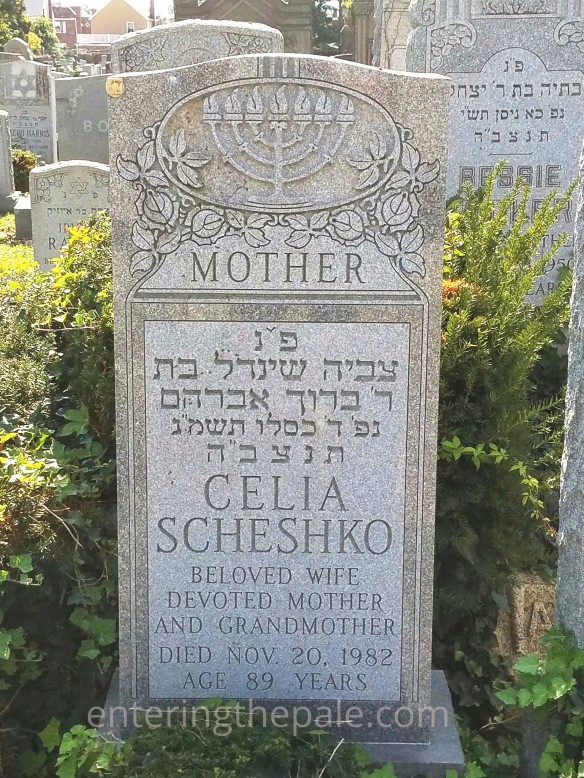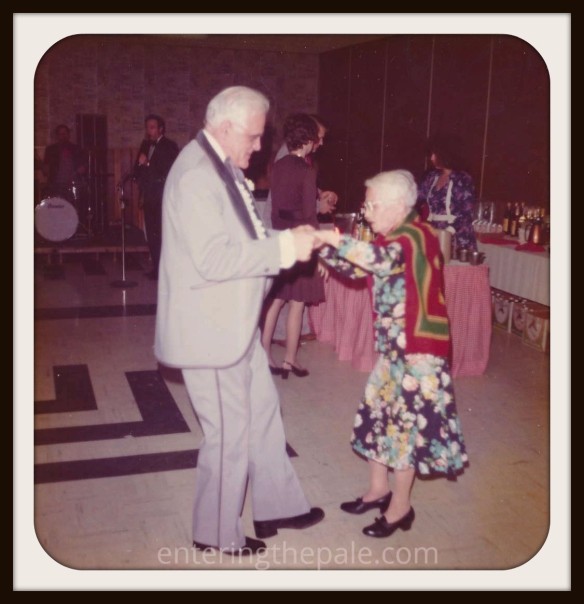We do have some information from other relatives about the gardener’s (aka my husband’s) maternal history, but it will need more work in the future. For now, we want to focus on his paternal relatives because we know so little of them.
I wrote to the gardener’s cousin and asked if he had any documents passed down in the family. Unfortunately, he does not. At some point, anything that would help in researching the family history was thrown away or lost.
But I started to think that since both his paternal grandparents immigrated to this country and died here, that the cemetery and their headstones would be the first step.
They are both buried at Montefiore Cemetery in Queens. I was able to confirm that on Find-a-grave. I asked our cousin to take photos of the headstones because I didn’t think it was a good idea to ask my daughter who is not familiar with areas of NYC outside where she lives and works–and she has no car. He was very willing, but then Sharon from Branches of our Haimowitz Family Tree told me that I could just ask the cemetery to take the photos for me for $10! So much easier. It turned out to be quick, too, because the photos showed up in my mailbox seemingly instantaneously. Thank you to Carl!
I knew Celia because when the gardener and I got married she was elderly. She traveled from NYC to Michigan for our wedding and brought her own food with her as she was worried that she wouldn’t be able to get kosher food in Kalamazoo.
She was a tiny little lady. Here is a photo of her dancing with her son, my father-in-law Murray, at our wedding.

Since Isidore passed away in 1953, I wasn’t even born yet, so I never met him. But his presence was always a part of the family that I married into.
I think these are extraordinarily beautiful headstones–the details are marvelous.
What did we learn from the headstones? We already knew their names and the dates they died. But we might have learned the year they both were born–Isidore’s by taking 1953 and subtracting his 68 years and hers by taking 1982 and subtracting her 89 years. Time will tell if we are right.
By translating the Hebrew we have learned that his father was listed as Shimon, and that Isidore’s Hebrew name was Itzchak Meir (my husband was named for him).
Celia’s Hebrew name was Tziviah Sheindel (Tzivia Shaindel). In fact, our daughter is named for her and for my grandmother–Miriam Shaindel. Several people translated the headstone, just to make sure. This is the one from a kind soul on a Facebook group.
Line 1, [abbreviation]: Here lies buried, L2: Tziviah Sheindel, daughter of , L3: Mr. Baruch Avraham, L4: died 4 Kislev 5743, L5: [abbreviation] May her soul be bound in the bond of life.
The “Mr.” is seen in the abbreviation resh (R) followed by what looks like an apostrophe. This is for the Yiddish word Reb (according to the translator above), which is a term of honor closest to mister. Remember in Fiddler on the Roof Tevye is sometimes called Reb Tevye?
It was very helpful to locate the headstones as an initial step, and I’m glad we tried what is closest at hand first. Having the names of the fathers will be a big help in searching in eastern Europe.

Great start! Those Hebrew names are always important because they reveal the father’s name. Too bad they don’t include the mother’s name. And could she have found kosher food in Kalamazoo?
LikeLiked by 1 person
It was fabulous. We had no idea the names of their fathers until this! You were right about the reb thing, it appears, so time will tell about family stories . . . . Kosher in Kalamazoo. That sounds like a movie haha. Well, we ordered fish for her at the dinner, but to come for a long weekend like that in the middle of an ice storm and to find enough food to eat that is kosher, it would be a challenge for her. Not impossible, but a challenge–and she was dependent on her daughter and son-in-law to get around, so I think she was smart to play it safe.
LikeLiked by 1 person
Keeping kosher means different things to different people, of course. Some wouldn’t eat even bread if it weren’t marked with an OU, others (like me) will eat in restaurants but only eat fish or vegetarian meals. I would never be able to travel if we were strict about it!
LikeLiked by 1 person
I have friends that keep kosher at home, but not when they are out. You are right. Restaurants can be very difficult.
LikeLiked by 1 person
Yes, but I am so used to the fact that there is usually no more than two choices on any menu that I am fine with it. (I wasn’t kosher out of the house until 1993.)
LikeLiked by 1 person
How is it when you travel abroad?
LikeLike
Same. We eat a lot of Italian food wherever we go—pasta, pizza—and sushi and salads and eggs and fish.
LikeLiked by 1 person
That sounds good. As the wife of a celiac, though, I have to say, what are pasta and pizza? heh
LikeLike
I think if I had to give up gluten, I would be miserable. Bread and pasta are what make eating all those vegetables appetizing!
LikeLiked by 1 person
He is pretty miserable when we travel unless we find a safe restaurant!
LikeLiked by 1 person
It must be hard. I have a friend whose husband has celiac; they are big travelers. I am not sure how he does it.
LikeLiked by 1 person
Maybe he’s skinnier and doesn’t need to eat so much. Or he might not have it as bad as the hubster. His is quite severe, and he has many other food intolerances–the list continues to grow.
LikeLiked by 1 person
Awful. Like I said, my list is very long, but I am so lucky that gluten is not on it. Very often when traveling, I find I am eating mostly bread and pasta.
LikeLike
Those headstones are really beautiful! And what a great service the cemetery offers – I’m impressed!
LikeLiked by 1 person
I was so surprised, Pauline. I am not used to cemeteries being so helpful!
LikeLiked by 1 person
Perhaps they are leading the way so others might follow 🙂
LikeLiked by 1 person
I suppose some of the smaller cemeteries or ones that have nobody on staff at all there is little hope for unless taken over by a good volunteer group!
LikeLiked by 1 person
I used to have a boss who was Orthodox at home, but said he got tired of eating salad at restaurants. If he could fix a dish at home and have it kosher, he’d eat it out. Chicken and beef were OK, cheeseburgers and shrimp were not.
I’ve been a vegetarian for a little over 40 years, and you get used to finding things on the menu that will work. The appetizers are usually good, and vegetarian eating is becoming more mainstream. which makes life easier. GF food is also becoming a lot easier to find.
LikeLiked by 1 person
Definitely not shrimp! Yes, it’s much easier to find items in restaurants for alternative diets, but my husband is a gluten canary-in-the-coalmine. He can tell you if there was 1/500 of a slice of bread contaminating the food. And that’s the problem with eating in restaurants–even if the food is gluten free, it gets contaminated in the kitchen from the other food. The only way to be pretty sure is to eat in a completely gluten free environment, which is a rare G.F.
bakery/sandwich place.
LikeLike
Interesting about the name Scheshko. I once worked with a Shasko who came from Saskatchewan where there are many folks with Ukrainian heritage. I bet it is a derivative form of the name!
Looks like another interesting blog, Luanne!
LikeLiked by 1 person
It does sound like he was Ukrainian! I am going to enjoy seeing if we can find out the origins of our Scheshko name because I see so many variations and think there might be more than one origin–or not!!! Thanks so much, Ian!
LikeLike
Those are beautiful gravestones.
LikeLiked by 1 person
Thanks so much. I think so, too. Really special.
LikeLike
You are right about the headstones, they are especially beautiful. And a great place to start!
LikeLiked by 1 person
Not only beautiful, but good information, too, with the names of the fathers :)!
LikeLiked by 1 person
Yes!
LikeLiked by 1 person